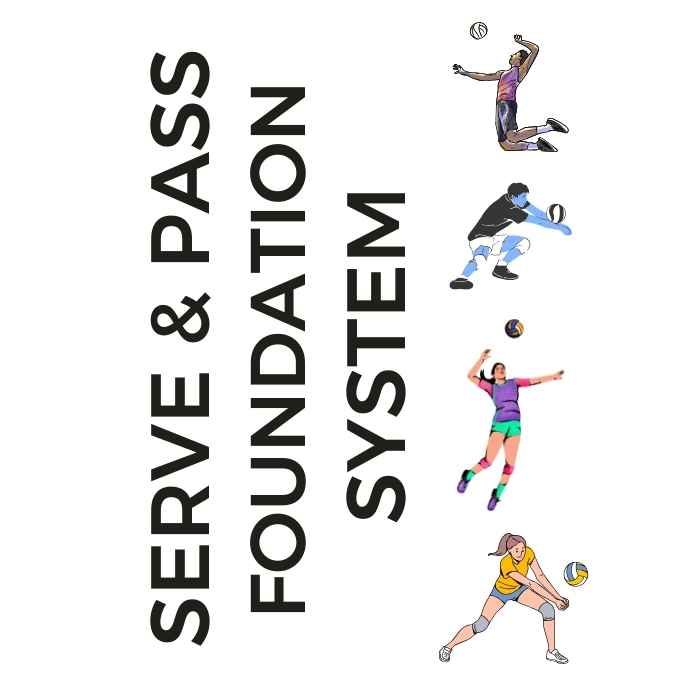
Serve + Pass Foundation System: The Complete Skills Arsenal The two-skill mastery system that transforms inconsistent players into the athletes coaches build their lineups around. Stop Struggling With The Two Most Important Skills In Volleyball!
- Improve Your Volleyball with Coach April
- Volleyball Checklist
- Advanced Libero Techniques
Unlocking the Secrets of Advanced Libero Techniques For Volleyball Mom
Discover advanced libero techniques to boost your volleyball IQ, support your child's defensive skills. Perfect for moms eager to encourage their young liberos.
If your athlete struggles with consistent serve receive, gets subbed out, or is overlooked for playing time—this is the fix you’ve been looking for.

Struggling with passing consistency?
I help talented passers tired of getting pulled from games because of inconsistent serve receive skills BUILD passing confidence without expensive private lessons using the same 3-step system that's helped dozens of my athletes get recruited.
Download my eBook for $17.99 and start building the passing confidence that keeps you on the court—and gets you seen by college coaches.
As a volleyball mom, understanding the intricacies of the advanced libero techniques associated with your child's position can make a world of difference in how you support their journey.
If your young athlete is taking on the crucial role of libero, you're about to enter into a world of specialized defensive techniques.
In this guide, I'll explore advanced libero techniques that go beyond basic digs and passes.
By familiarizing yourself with these next-level defensive moves, you'll be better equipped to discuss strategies, offer encouragement, and celebrate your child's defensive abilities on the court.
Let's work on raising your volleyball IQ and become the ultimate support system for your budding libero!
Defensive Dynamos: Complex Moves Your Young Libero Might Tackle
1. The Chicken Wing: Not Just for Dinner!
Imagine your child quickly bending their elbow to deflect a fast-moving ball upward.
That's the chicken wing! This emergency technique is crucial when traditional methods aren't possible due to the ball's speed.
One Step Sprawl
Volleyball Digging Information
2. The Sprawl: Superhero Moves on the Court
Picture your libero swooping down, arms extended, to save a ball inches from the floor.
That's the sprawl!
This move requires quick reflexes and body control. Praise your child's efforts when you see them attempting this challenging technique.
3. The Deep Dish: Serving Up Some Defensive Magic
While primarily a setting technique, the deep dish can be a valuable defensive tool. It involves allowing the ball to descend lower than usual before contact.
Your libero might use this to control tricky passes or tips. Remind them to use it judiciously, as there are restrictions on libero setting.
Oops Moments: Understanding Defensive Challenges
1. Six Pack and Facial: When the Ball Fights Back
These terms describe the unfortunate event of getting hit in the face with the ball. While not a goal, understanding why this happens can help your child improve.
Encourage them to stay alert and keep their eyes on the ball to avoid these mishaps.
2. Chester: A Chest-Level Challenge
Similar to a six pack but involving the chest, a chester occurs when a libero doesn't get their arms in position quickly enough.
Support your child in practicing their footwork and reaction time to prevent these situations.
3. Popcorn: When Digs Go Wild
A popcorn happens when a dig sends the ball flying unpredictably.
While sometimes unavoidable, you will see when it happens your player's coach will have them adjust their platform when contacting the ball to minimize these erratic plays.
Strategic Smarts: Positioning Your Libero for Success
 Great liberos don't just react; they anticipate. Encourage your child to study opponent tendencies and communicate with teammates. (photo Al Case)
Great liberos don't just react; they anticipate. Encourage your child to study opponent tendencies and communicate with teammates. (photo Al Case)Great liberos don't just react; they anticipate what is going to happen by reading the situation.
Encourage your child to study opponent tendencies and communicate with teammates.
Teach them to watch the setter and hitters closely to predict where the ball might go.
Help them understand how their position relates to the team's blocking strategy. By developing these strategic skills, your young libero will be steps ahead of the competition.
Practice Makes Perfect: Supporting Your Libero's Growth
1. Encourage specific drills focusing on each advanced technique.
2. If possible, record your child's games to review so they can see their form and discuss their form together.
3. Remind them to practice at game speed to build quick decision-making skills.
4. Support them in seeking feedback from coaches or experienced players.
5. Help create challenging practice scenarios at home to boost their confidence in game situations.
Championing Your Libero's Journey
By understanding these advanced libero techniques, you're now better equipped to support your young defender's volleyball journey.
Remember, your encouragement and understanding are key to their growth.
Celebrate their efforts, both big and small, as they develop into a skilled and confident libero!
Do You Follow Me on Pinterest?
 Private or semiprivate volleyball indoor/sand lessons are an excellent way for young Las Vegas high school volleyball players to quickly improve their individual skills through a private or semi-private coaching experience.
These lessons are conducted by former pro volleyball player, former USA Volleyball High Performance instructor and Evaluator and Tstreet Vegas 18s head Coach April Chapple on a weekly basis.
Sign up now!
Private or semiprivate volleyball indoor/sand lessons are an excellent way for young Las Vegas high school volleyball players to quickly improve their individual skills through a private or semi-private coaching experience.
These lessons are conducted by former pro volleyball player, former USA Volleyball High Performance instructor and Evaluator and Tstreet Vegas 18s head Coach April Chapple on a weekly basis.
Sign up now!Follow me on Pinterest Volleybragswag to improve your game even faster!
I share alot of individual, partner and easy-to-do volleyball serving drills we do in class with my followers.
Many of these volleyball practice drills you can do at home by yourself or try at your next practice with your teammates.
If you're a B team or JV player trying to make varsity next year...your goal should be to complete 1000 reps a day of at least three of the basic skills on your own...volleyball passing, serving and setting should be at the top of the list.
From Lady Vol to Legend: Coach April Produces Powerful Passionate Players...is that you?
What Are You Looking For?
Click to Download Your Pre Serving Ritual Mastery Checklist pdf:
🎯Volleyball Pre Serving Ritual Guide -
Players! Learn How To Transform Your Serve from Weak to Weapon
Click to Download Your Parent's Volleyball Serving Checklist pdf
🎯Parent's Volleyball Serving Checklist Guide
Parents! Help Your Player Develop Championship Serves (Even If You've Never Played)

Hi there!
Thanks for stopping by. Hope you learned something today that will help you reach your volleyball goals.
Be sure to subscribe to my email newsletter so you can learn more each week!
Stay strong! Stay motivated!
-Coach April

SUSCRIBE to my email newsletter below!
 Click to learn more about the weekly volleyball classes and clinics or email info@imrpoveyourvolley.com for information
Click to learn more about the weekly volleyball classes and clinics or email info@imrpoveyourvolley.com for informationCongratulations to my seven Boys-18s Vegas Volley club players who played in two state championship finals yesterday, the 3A and 5A State champinship finals at Sunrise Mountain High School.
TOURNAMENT CHAMPIONS!
A-1 Vegas Volley VBC
In It To Win It Tournament
May 2 - 4, 2025 Tournament
Gold Medalists
18s Premier Division
Vegas Volleyball's Unsung Heroes: Celebrating Moms with Peace Love Volleyball Shirts
Ready to energize your volleyball mom journey?
Subscribe to my 'Producing Powerful Passionate Peaceful Players' email list above on ImproveYourVolley.com.
You'll receive energy-boosting tips, exclusive insights from me, Coach April Chapple on maintaining momentum in volleyball.
Let's power up the Vegas volleyball scene together!
Recent Articles
-
5 Essential Serving Tips from Tennessee's #2 Career Aces Record Holder
Dec 09, 25 11:39 PM
I've identified the 5 essential serving tips that separate confident servers from struggling ones and you'll serve with the confidence that creates aces -
The Volleyball Toss How Consistent Is Your Ball Toss Before You Serve?
Dec 07, 25 12:29 AM
The volleyball toss for the overhand serve needs to consistently be two feet up in the air and one foot in front of front foot which puts the ball in front of your serving arm. -
Shop Small: Real Volleyball Training With + Results From A Real Coach
Dec 03, 25 10:30 AM
Support a woman-owned business. Get training from a former elite pro with 13+ years coaching experience. Ditch the big box store--invest in proven results.





































